Big congrats to a team of three North Americans that won the first ever Atomic Waymaker challenge that took place over the weekend of April 6-7, 2013.
Reiner Thoni, Andrew McNab (both Canada), and Mark Smiley (US) named their team The United States of Canada and went to take on nasty weather and other seven teams.
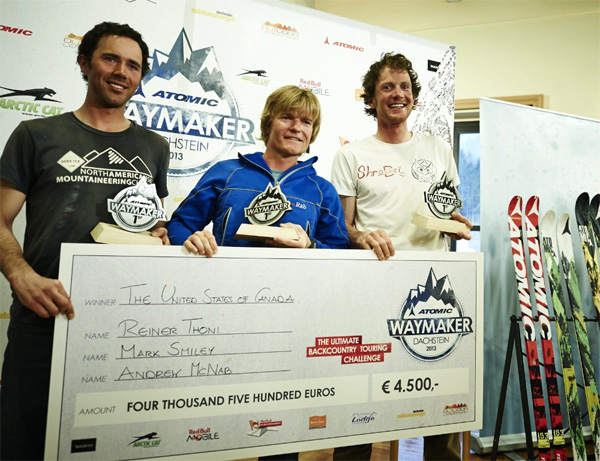
Atomic Waymaker – atomic what?
Before we dive into the interview let’s define what the Waymaker did and what it didn’t aimed to be.
“The aim of the Waymaker is a perfect ski touring day” – claimed the official website. The format was refreshingly new.
It was a two day backcountry ski touring competition very different to any skimo race before.
Eight teams of three were let to tour freely within a predefined area. Each team submitted their own route plan, which they were expected to stick to, unless unpredictable conditions would render the route too dangerous.
The winning team was determined by a jury that assessed each team’s performance based on the following criteria:
- Skiing – descent
- Touring – ascent
- Mountaineering – climbing
- Data
- Overall route
» For more details on how the Waymaker worked see this document – Atomic Waymaker 2013 rules and regulations (PDF).
And what Waymaker wasn’t?
The Waymaker was not a timed mass start race where the first guy/team across the line won. The route was not marked and there really were no check-points.
Interview with the winning team – Reiner, Mark and Andrew
Q: Only eight teams were going to be accepted to participate in this first ever Waymaker. How did you guys get in?
We applied with a short resume about our skimo racing and general ski mountaineering experience, as well as why we felt we would be good for the event.
Q: Where did this first edition take place? How big was the area where all teams were let to roam freely?
It was in the Dachstein region of Austria. The area of the competition for day 1 went from the Odensee Lake in the east, then across the Dachstein Plateau to the Krippenstein Lodge.
Day 2 went from the Lodge into the peaks of the Dachstein and then out to Gosausee Lake to the west.
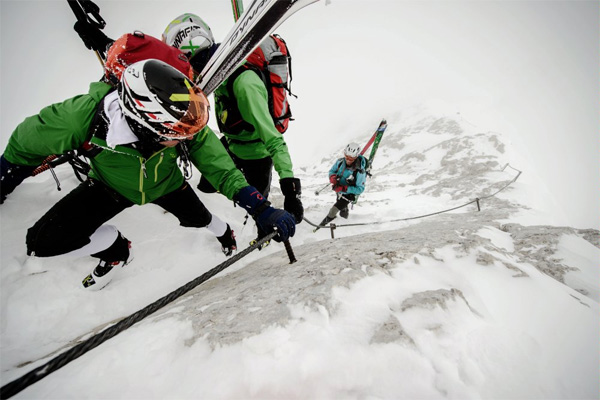
Q: It was a two day event. Were you sleeping in the backcountry or in a village?
On the night of day 1 we stayed at the Krippenstein Lodge at 2100m. The other nights we stayed at the sports complex in Obertarun.
Q: Did each team submit two routes (one for each day) or more?
One for each day with the ability to change the route depending on conditions.
On the Friday before the race we had to submit our plans for both days, but were able to change them in the field if we felt the conditions were not safe or if we did not think we were going to make it in time.
Q: Could your planned route be as gnarly as you wanted or the organizer had some input in that?
We could plan as gnarly of a route as we wanted, but points would be docked for taking excessive risks beyond a teams ability levels. So it was not in your favour to go for anything too ridiculous.
On the Friday, we had to submit our route plans to the judges/organizers for review, if they felt that things were too risky they could say so and suggest changes.
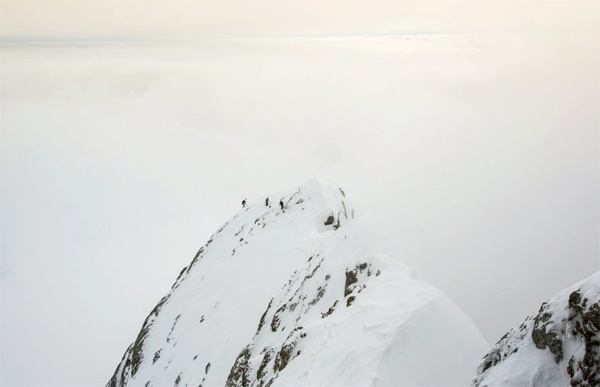
Q: Did you choose your route only based on a map or did you get to know the area before?
For the few weeks leading up to the event we spent sometime looking at the area on Goggle Earth, as well on a topo map, which gave us a general idea of what the area looked like.
We came over to Austria on the Monday before the event and then spent the 3 days leading up to the event exploring the area as best as we could.
For the first 2 days we had very poor weather and could not see very much. But we gathered as much intelligence as we could and were able to come up with a pretty good game plan for day one, which was in the mellow terrain of the Dachstein Plateau.
We got lucky on our third day of recon. We had blue bird conditions and were able to get out into the Dachstein Peaks, which was awesome! That really made the difference for us because we were able to find some really sweet lines and able to put together a good plan for the second day.
Q: What did you feel were your strengths compare to other teams?
We felt that between the 3 of us we had a very diverse skill set. From strong being skimo racers to strong alpinists, all with solid endurance and good photography/story telling skills, and great passion for adventuring in the mountains.
We also spent a lot of time leading up to the event studying all the documents the organization had sent us, so that when it came time for us to do recon we knew what were looking for in terms of meeting all the outline judges’ criteria.
Q: What gear did you choose to complete your planned route with? Skimo race gear or other?
There was a mandatory gear list. We also then chose gear that we felt would make our team the most efficient at accomplishing the criteria the judges were looking for, as well as for moving the most efficiently through the mountains.
Mark and Reiner were on race skis to gain the advantage of efficient travel. Andrew was on a wider ski which worked well for trail breaking and for being able to ski strong which helped for photos.
Overall we tried to run as lite as we could and split the team gear the most efficiently to get the job done.
Q: Did organizers equip you with any other gear or tracking devices?
Yes, the organizations gave us:
- 2 radios
- 2 SPOT transmitters for emergency use
- 2 Android phones with GPS tracking apps running which transmitted out location to the live tracking software
- 1 Sony smart phone for taking pictures that was also linked to the GPS tracking app, so that we could up load our photos while we were racing to the live GPS tracking system
The photos that we took were used by the judges to evaluate our route and the lines that we choose, i.e. looking at the snow conditions and technical skills used.
The photos were a very important part of the competition for they are what told our story of the day. The more creative and better the photos were the easier it was for the judges to understand our idea of what our “ideal” day of skiing touring was.
On day 1 we were also given 3 Go-Pro cameras and on day 2 we had 2 Go-Pro cameras. They were for capturing images for the film crew to use in the video that they are going to make of the event.
We were also all give a Sunnto Ambit GPS watch, which was also used to track our movements in the mountains.
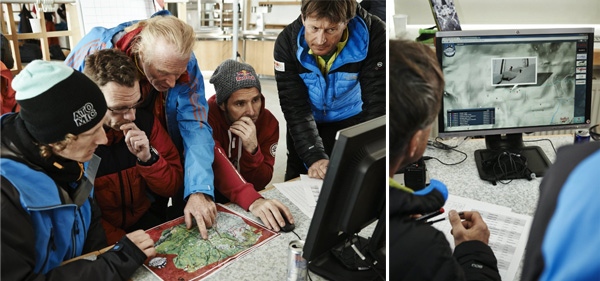
Distance and elevation gain was one of the 5 points that the judges looked at, but was not the most important aspect.
Day 1
Q: How was the start? All teams together but each running in their own direction?
The start was done in 1 min intervals. 6 teams went a similar way, up the first climb. We went a different route, up through the trees, but all ending up at the same first high point, and then we all went off into different directions again.
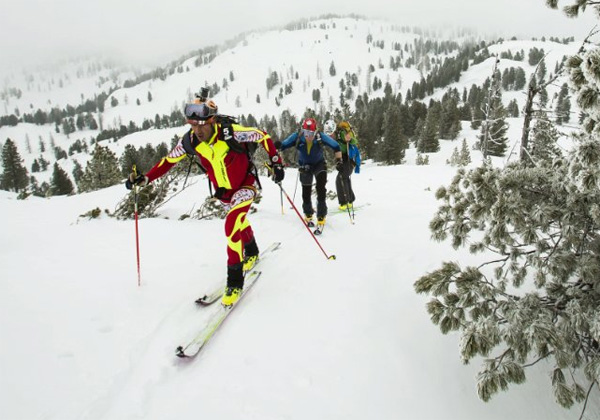
We were all involved in the navigating and the route planning. We had 2 GPSes of our own (one of which was a Google Earth based system) as well as a 1:25,000 topo map of the area.
At times the navigating was very challenging because the terrain was rather rolling and undulating, with lots of little gullies and large winded features. Trying to navigate through this terrain with anywhere from 5 to 50 feet visibility was very challenging and rather draining.
Q: Approximately, how many kilometers and vertical metres did you travel on day 1?
About 30 km and 3100 m in 8.5 hours.
Q: How many ascents and descents did you do? Any steep or technical passages?
Five main descents and 6 climbs. The second last climb was done up a fixed rope section on the Damuelkogel Peak, every team had to do this route in their day.
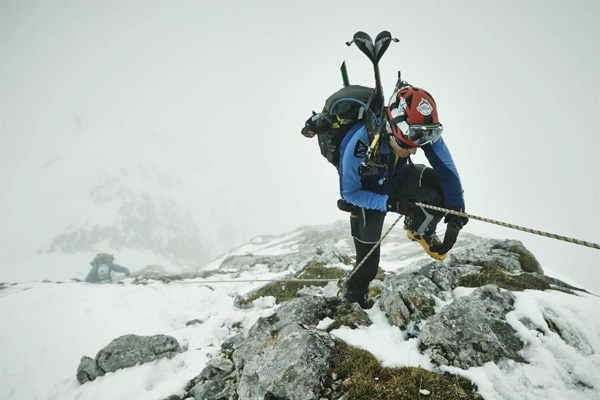
Whiteout navigation. All the rest went pretty smooth.
Day 2
Q: Due to bad weather the Waymaker got terminated after few hours into day two. What were the weather and snow conditions like?
The race was cancelled after 6 hours of racing because on the final descent the visibility was approx. 1 metre and the snow was getting too warm and unsafe.
Q: How far did you get on your route that day?
We got over half way through our planned route. We had attained our main objective, and were en-route to climb the main peak of the region when we were turned around 200 m from the summit.
Q: How did the termination work out with 8 teams out there? Were you picked up or they told you were to go?
We were told by radio that the race was over and that we were to return to the Krippenstein Lodge, where we had started that morning.
What did you think of the Waymaker?
Q: You pulled off a massive feat by winning it. Did you think you will be in the mix or was it a complete surprise?
We went into the event with the plan to have a good time and give it our all, with no real expectations or personal pressure.
Being that it is a judged event and a brand new format in a mountain region that we were not that familiar with it was pretty hard to tell, really, how it was going to all pan out.
Q: Going through it all (pre-race meeting, route planning, going out there…), what do you think of the Waymaker format and overall experience?
It’s a good format and worthy of replicating. It felt like a good nature progression of the sport.
Q: Would you return?
For sure!
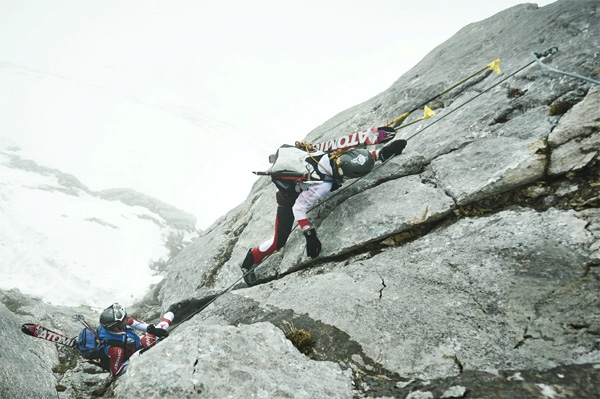
Q: Obviously, the free use of terrain is very exciting; however, that severely restricts the number of participants. Because of that, do you think this format of “racing” is tough to grow? What is the real goal of the Waymaker?
By being a restricted entry it makes for a more elite field of competition, so that will help it grow.
Part of the reason for the Waymaker was to help bring the Atomic brand more into the backcounrty touring market and to create a new way to showcase the sport of ski mountaineering/backcountry skiing. It has a lot more potential for media growth and exposure than a typical skimo race.
Q: Was there a sign-up fee or the big sponsors paid the bill?
Sponsors paid the bill. Everything was covered. It was awesome; they took really good care of us, with great food and accommodation. All the organizers were super friendly and welcoming.
Q: North America has amazing terrain for such event. Do you think the Euros might bring it here? Or should we attempt something similar on our own?
The organizers have dreams to hold this event again and would like to have it in different locations each year. North America definitely has the terrain for such an event but it might be a lot more of a challenge to have it in NA due to litigation issues.
As well there is a lot more infrastructure in the mountains of Europe, which makes hosting of such an event a lot easier.
Q: Can’t end this without asking about Kilian Jornet who participated in one of the teams. He is The face for a lot of Atomic and Suunto advertising, two big sponsors of the Waymaker. Do you know, was it his idea for such an event?
The original idea for the event came from Heli Putz, whom was the head judge/chief organizer, as well as from Patrick Tritscher, who is the main man of marketing for Atomic.
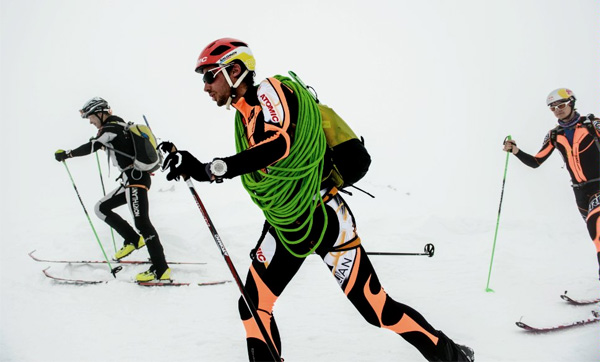
No sled rides but as many Red Bulls as you could handle.
Q: Do you think that such a format requires a much bigger organizational undertaking than a skimo race?
The overall costs of an event such as the Waymaker (therefore the organization of sponsorship and funding sources) are probably larger than a typical skimo race.
The organization of the event itself is probably at the same level of a skimo race. Because in a skimo race you need to have people setting a track and out on course to ensure that racers are staying on a course. In the Waymaker, the only real reason that there were people on course was for media i.e. photo/cinematographers.
Would you try the Waymaker format?
Thank you for making it all the way here.
And what do you think of this new “racing” format for ski mountaineering / ski touring competition? Leave your opinion in the comments below.


Chuck says
Amazingly Inspirational… that’s the way to put us on the map!
Michael Silitch says
Great result and interesting to hear about this race. Good job guys!
Terry says
Great story, Stano! Interesting idea for a race. Impressive win by the N Americans!
Tim Zander says
Heck yeah! This looks super badass, sort of adventure racing combined with skimo.